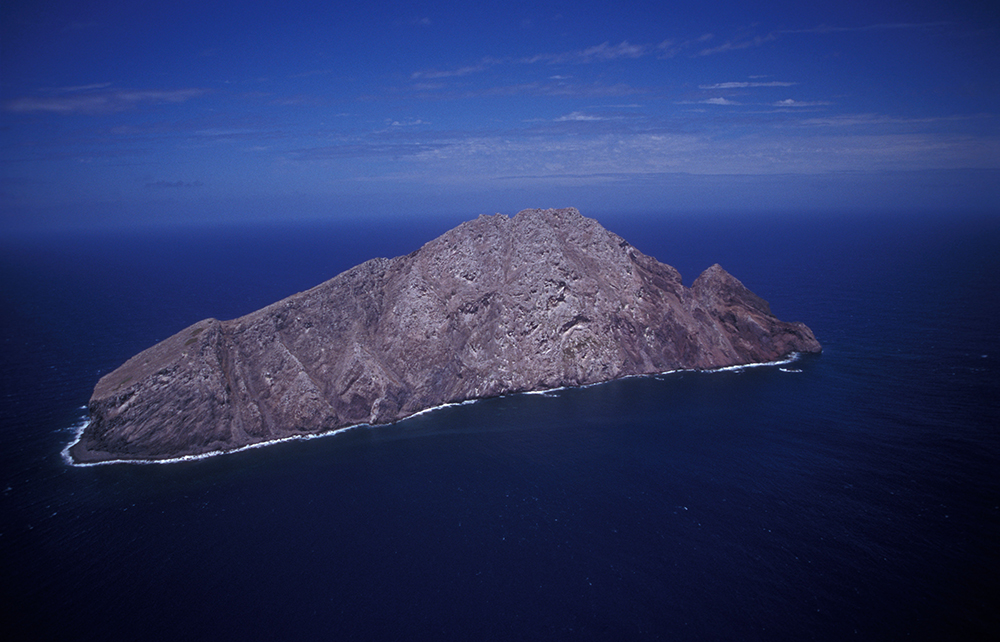There is an island in the Caribbean so small that it doesn’t appear on many world maps. Its name is Redonda; one of its kings, the Spanish writer Javier Marías, died two months ago. It’s an unforgiving place, uninhabited and windswept, basically a large rock a mile long and about a third of a mile wide. But birds like it, particularly a species called the booby, whose calls sound like a person crying out: ‘Oh no! Oh no! Oh no!’
The fantasy kingdom even had a national anthem – and a flag designed by the Duke of Guano
The island is the subject of the Canadian writer Michael Hingston’s often excellent Try Not to Be Strange. I can see booksellers scratching their heads over where to shelve it. Part memoir, part travelogue, it’s also a beer-soaked history of pub-going in mid-20th-century Soho, and an exhaustive record of a made up and deeply eccentric monarchy.
Redonda now belongs to Antigua and Barbuda, but in 1880 when it was nobody’s in particular, a delegation set sail from nearby Montserrat to carry out an unlikely mission: the coronation of a 15-year-old boy. The ceremony was dreamed up by a local ship-owner, Matthew Shiell, who believed he was the long-lost descendant of Irish kings, so felt that his son should rule Redonda as a form of compensation. Matthew Jr recalled the coronation decades later as ‘a day of carousal’, in which a local bishop anointed him King Felipe I. Five years later, he emigrated to London, where the young head of state reinvented himself as M.P. Shiel, a science-fiction author and prolific pen-for-hire.
The monarchy might have died with Shiel had he not befriended the poet John Gawsworth and decided to appoint him heir. They sealed the deal the way you would: by slicing open their wrists with a penknife and mixing their blood. As Kingston recounts, Gawsworth took his duties rather more seriously than his predecessor, and was soon issuing proclamations, dressing for the part (in a special velvet jacket) and bestowing titles on friends and drinking buddies. Lawrence Durrell and Dylan Thomas were among the many literary luminaries in on the game (though Thomas loathed the king: ‘Gawsworth would be a standing joke if he weren’t completely supine,’ he wrote; Gawsworth in turn called Thomas ‘a Welsh slag heap’).
Part of Gawsworth’s responsibility as monarch, as he saw it, was to keep Shiel’s legacy alive; so he promoted the dead king’s writing tirelessly, and took to sprinkling his ashes over his food. He also considerably enriched the fever-dream fantasy of the kingdom itself, persuading one courtier to compose a national anthem (‘O God Who Gave Our Island Soil’), and asking another – whom he’d appointed Duke of Guano – to design a flag.
A thread running through the book, which mars its fun, is how dreadful the first two kings were as citizens. Shiel was jailed for sexually assaulting a 12-year-old, and was a true wretch to his Spanish wife (‘You must remember, darling,’ he wrote to her before they divorced, ‘that I have my own little life to live, which is no longer than any other, and that it would be silly for me to spend it messing around with a group of amusing little women from Seville’). Gawsworth, meanwhile, squandered the promise of his youth on booze and violence; eventually he was sleeping in Hyde Park. On one of the last times Durrell saw the second Redondan king, he was pushing a big pram down Shaftesbury Avenue. Durrell was cheered – had the old poet found domestic bliss at last? – but when he looked into the pram, he saw only empty beer bottles.
Recently, Redonda’s kings have been rather more appealing. Since Gawsworth’s death in 1970, more than a dozen people have claimed the title, partly because of his unfortunate habit of handing out titles and grand promises in exchange for drinks. A few claimants have actually visited the island (no mean feat, given its remoteness), including the extremely nuts, and now dead, King Bob the Bald, as well as Jon Wynne-Tyson, a visionary vegetarian, who hauled up a flag made of his own pyjamas.
And of course, Javier Marías ruled Redonda from afar in the final two decades of his life, and filled out the role with elan. As King Xavier I, he stacked his court with writers and filmmakers, including the sociologist Pierre Bourdieu (who was made Duke of Uprooting), Pedro Almodóvar (Duke of Tremula), Umberto Eco (Duke of the Island of the Day Before), Ian McEwan (Duke of Black Dogs), and Marina Warner, who was offered a duchy just last year (she accepted, and is now Duchess of Phantasmagoria, don’t you know).
By the end of the book, readers may feel they know more about the Redondan monarchy than about, say, the Danish royal family, or even the British one. I imagine some won’t be charmed – the kingdom is essentially an elaborate joke, embroidered upon by generations of slightly addled, often desperate and mainly male egotists – but I was. A Redondan gong for Hawsworth seems in order: perhaps he could be made Duke of Rather Interesting Non-fiction.






Comments